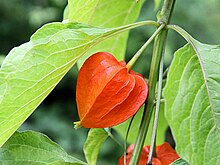Alkekengi
| Alkekengi | |
|---|---|

| |
| Alkekengi officinarum fruit with the red husk | |
| Scientific classification | |
| Kingdom: | Plantae |
| Clade: | Tracheophytes |
| Clade: | Angiosperms |
| Clade: | Eudicots |
| Clade: | Asterids |
| Order: | Solanales |
| Family: | Solanaceae |
| Subfamily: | Solanoideae |
| Tribe: | Physaleae |
| Genus: | Alkekengi Mill. |
| Species: | A. officinarum
|
| Binomial name | |
| Alkekengi officinarum | |
| Synonyms[1] | |
| |
Alkekengi officinarum, the bladder cherry,
Description
It is easily identifiable by the large, bright orange to red papery covering over its fruit, which resembles
Research has shown
Cultivation


It is a popular ornamental plant, widely cultivated in temperate regions of the world, and very hardy to below −20 °C (−4 °F).[7] It can be invasive with its wide-spreading root system sending up new shoots some distance from where it was originally planted. In various places around the world, it has escaped from cultivation.[8]
In the United Kingdom it has been given the Royal Horticultural Society's Award of Garden Merit.[7][9]
History
Physalis alkekengi has been used for a wide range of purposes in traditional medicine for around two millennia. It was used to heal fever, induce mental serenity, and assist in childbirth, according to ancient Chinese books including the Erya and Shen Nong Ben Cao Jing. Its usage in reducing heat, boosting energy, and aiding in diuresis was also mentioned in Li Shizhen's Ming dynasty Compendium of Materia Medica. The plant's juice was thought to be useful in treating jaundice. This traditional Chinese medicine's lengthy historical use illustrates the wide range of therapeutic uses.[10]
Traditional uses
The dried fruit is called the golden flower in the
In
Chemical constituents
Alkekengi officinarum contains a wide variety of
.It also contains caffeic acid ethyl ester, 25,27-dehydro-physalin L, physalin D, and cuneataside E.[20]
More than 530 different chemicals, including steroids, flavonoids, alkaloids, phenylpropanoids, sucrose esters, piperazines, volatile oils, polysaccharides, amino acids, and trace elements, are present in Physalis alkekengi. Its many potential therapeutic qualities, including those that are anti-inflammatory, antibacterial, antioxidant, hypoglycemic, analgesic, anti-tumor, and immune-regulating, are attributed to these well-researched constituents.[10]
Cultural significance

In Japan, its bright and lantern-like fruiting calyces form a traditional part of the
Fossil record
Alkekengi seed fossils are known from Miocene of Siberia, Pliocene of Europe and Pleistocene of Germany.[21] Pollen grains of Alkekengi officinarum have been found in early Pleistocene sediments in Ludham east of Wroxham, East Anglia.[22]
Taxonomic history
Alkekengi officinarum was previously included in the genus Physalis until molecular and genetic evidence placed it as the type species of a new genus.[23][24]
References
- ^ The Plant List
- ^ "Physalis alkekengi". Eppo.
- ^ a b https://npgsweb.ars-grin.gov/gringlobal/taxonomydetail.aspx?id=470124 "Physalis alkekengi, Alkekengi officinarum". Germplasm Resources Information Network. Agricultural Research Service, United States Department of Agriculture. Retrieved 20 December 2017.
{{citation}}: Check|url=value (help) - ^ BSBI List 2007 (xls). Botanical Society of Britain and Ireland. Archived from the original (xls) on 26 June 2015. Retrieved 17 October 2014.
- ^ USDA, NRCS (n.d.). "Physalis alkekengi". The PLANTS Database (plants.usda.gov). Greensboro, North Carolina: National Plant Data Team. Retrieved 1 October 2015.
- ^ S2CID 86411770.
- ^ a b "RHS Plantfinder - Physalis alkekengi". Retrieved 27 April 2018.
- ^ "1. Physalis alkekengi Linnaeus". Flora of China.
- ^ "AGM Plants - Ornamental" (PDF). Royal Horticultural Society. July 2017. p. 78. Retrieved 27 April 2018.
- ^ S2CID 261671026.
- ^ Rasheed N.M.A., Shareef M.A., Ahmad M., Gupta V.C., Arfin S., Shamshad A.K. "HPTLC finger print profile of dried fruit of Physalis alkekengi Linn." Pharmacognosy Journal 2010 2:12 (464–469).
- ISBN 978-0-917256-20-2. Retrieved 15 May 2009.
- ^ Berendes, J. (ed.) Arzneimittellehre in fünf Büchern des Pedanios Dioskurides aus Anazarbos. Stuttgart. 1902. 405-08.
- PMID 5461642
- PMID 18348534
- S2CID 26532208
- PMID 16410969.
- ^ leishmanicidal Archived 15 May 2010 at the Wayback Machine
- ^ Choudhary M.I., Yousaf S., Ahmed S., Samreen, Yasmeen K., Atta-ur-Rahmang "Antileishmanial physalins from Physalis minima" Chemistry and Biodiversity 2005 2:9 (1164-1173).
- ^ YUAN Ye, XU Nan, BU Xian-kun, ZHAN Hong-li, ZHANG Meng-meng Chemical constituents of Physalis alkekengivar. franchetii (II) "Chinese Traditional and Herbal Drugs" http://en.cnki.com.cn/Article_en/CJFDTOTAL-ZCYO201012005.htm Archived 19 March 2022 at the Wayback Machine (Liaoning University of Traditional Chinese Medicine, Dalian 116600, China).
- ^ The Pliocene flora of Kholmech, south-eastern Belarus and its correlation with other Pliocene floras of Europe by Felix Yu. VELICHKEVICH and Ewa ZASTAWNIAK - Acta Palaeobot. 43(2): 137–259, 2003
- ISBN 9780521269414
- ^ "Alkekengi officinarum - Species Page - NYFA: New York Flora Atlas". newyork.plantatlas.usf.edu. Retrieved 18 August 2022.
- ^ "Plant database entry for Chinese Lantern (Alkekengi officinarum) with 35 images, 2 comments, and 26 data details". garden.org. Retrieved 18 August 2022.
External links
